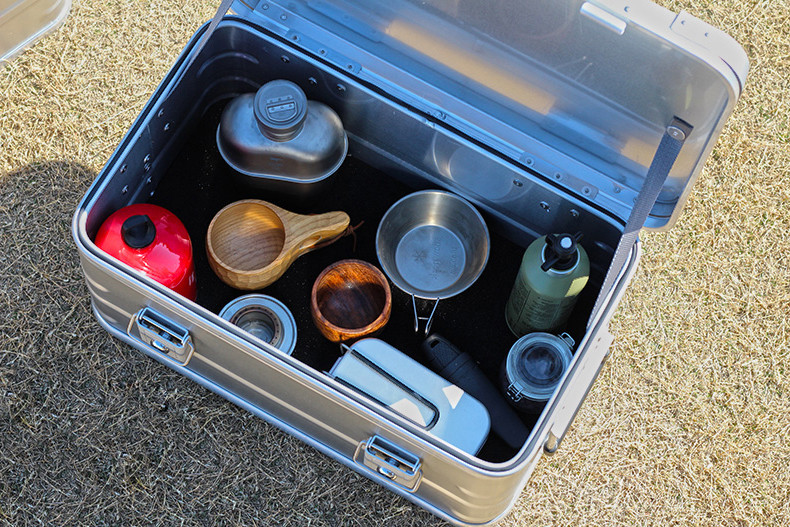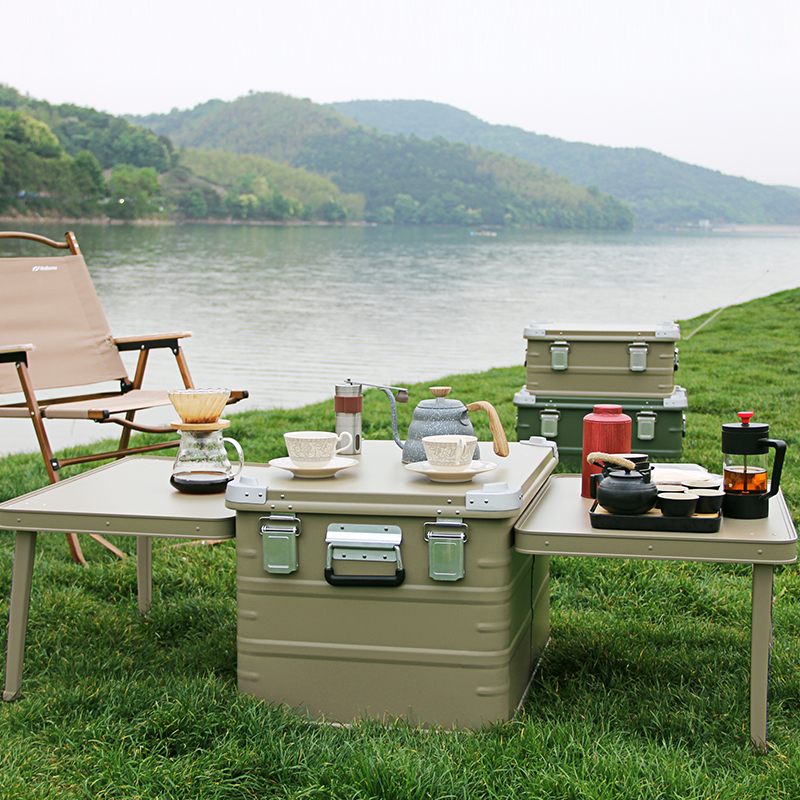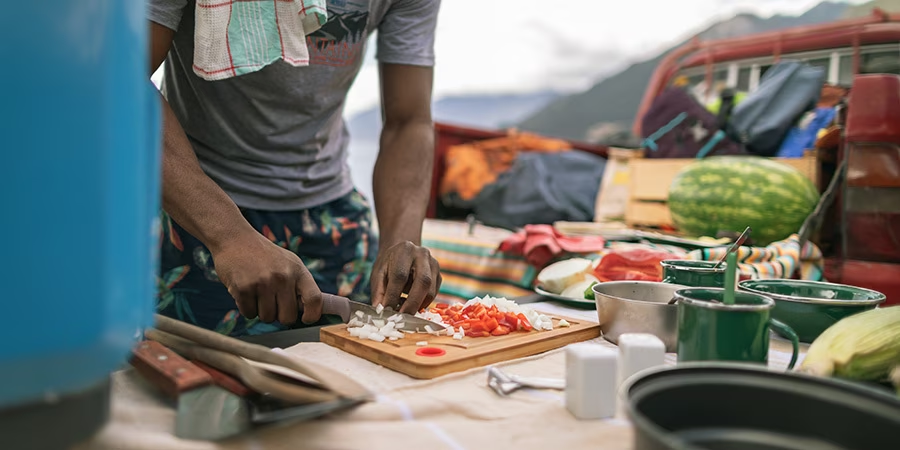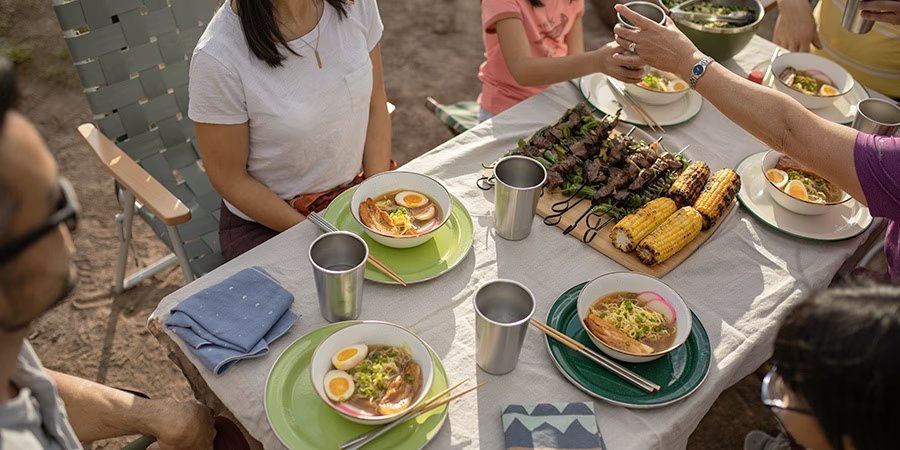Determine your cooking method: Decide on the type of cooking method you prefer for your camping trips. Options include a portable stove, a campfire, or a combination of both. This decision will influence the equipment and utensils you'll need.
Create a checklist: Make a comprehensive checklist of all the essential items you'll need in your camp kitchen. This list will vary depending on your cooking method, the number of people, and the types of meals you plan to prepare. Some basic items to include are:
Pack efficient cookware: Choose lightweight and durable cookware that suits your cooking needs. Opt for nesting pots and pans to save space. Non-stick pans are easier to clean. Additionally, consider carrying a coffee percolator or French press if you're a coffee lover.
Organize your kitchen setup: Designate specific areas for cooking, food preparation, and washing dishes. Use sturdy tables or countertops if available. If not, bring a camping table or create a makeshift setup using a sturdy board or flat surface supported by logs.
Food storage and organization: Store food items in sealed containers or resealable bags to prevent insects and animals from accessing them. Keep perishable items in a cooler with ice or ice packs. It's helpful to separate food items into categories, such as snacks, canned goods, spices, and fresh produce, for easier access.
Plan your meals: Before you head out, plan your meals in advance. Opt for meals that are easy to prepare and require minimal ingredients and equipment. Prepping some ingredients at home, like chopping vegetables, can save time and make cooking at the campsite more efficient.
Practice good hygiene: Maintain cleanliness and proper hygiene in your camp kitchen. Wash your hands frequently, especially before handling food. Use separate cutting boards for meat and vegetables to avoid cross-contamination.
Leave no trace: Always practice Leave No Trace principles when camping. Clean up after every meal, properly dispose of waste in designated containers, and ensure the campsite is clean before you leave.
Remember, safety is paramount when setting up and using a camp kitchen. Follow manufacturer's instructions for all equipment, be cautious when using open flames, and adhere to any regulations or guidelines set by the camping area you're visiting. Enjoy your camping adventure and the delicious meals you'll create!
While you can craft a rustic setup with nothing more than a tin can and a campfire, a fully stocked camp kitchen will offer infinite options come mealtime.
Build your kit from the ground up with a solid set of core pieces—but that doesn’t necessarily mean buying everything brand new. It’s likely you already have some of these items sitting around that can be repurposed for your camp box, or you can look for used options.

Beyond the basics, consider what else will elevate your cooking—and dining—experience.
You know that saying, “An ounce of prevention is worth a pound of cure”? Well, an ounce of preparation is worth, um, a pound of roasted marshmallows. “Do the majority of the work at home so when you do get out there, you can spend most of your time hiking and enjoying the area and the activities that you're there for,” says Matkin. “Even in the great outdoors, you don't want to spend the whole time in the kitchen.”
Here are some ways to minimize your at-camp to-do list:
Let someone else set up the tents and get the campfire going—it’s time to cook!

While it’s best to tidy up as you go (it’s never fun doing chores, and especially so on a full stomach!), you’ll need to wash dishes at some point after your meal. The tried-and-true method utilizes three “sinks,” or, more likely, three buckets or bins:
Step 1: Soak, then clean dishes in a container filled with hot water and biodegradable soap.
Step 2: Rinse dishes in a container filled with hot water.
Step 3: Do a final rinse in a container filled with cool water.
Step 4: Towel-dry or air-dry dishes.
Dirty dishwater disposal is where things get tricky: While it’s tempting to just dump it all onto the ground, this isn’t a great practice. Food scraps left in the water can attract animals, who will then claw at the ground in hunt of a tasty meal, potentially destroying grass and other foliage in the process, and possibly become habituated to human food. Instead, Matkin uses a piece of cheesecloth or pantyhose to filter out scraps, which he packs out or throws in the garbage. To dispose of the remaining gray water, he recommends dispersing it as widely as possible, so that it doesn’t puddle up in a single spot. (Many established campgrounds may also have designated areas for washing dishes).
Speaking of animal attractants, it’s important to research food storage regulations wherever you’ll be camping and store your food thoughtfully so critters aren’t tempted to break into your leftovers (or bother you while you’re cooking). Matkin loves hard-sided coolers such as those by or YETI or RovR Products, which are not only certified bear-resistant, but also come with dividers and other accessories that help you stay organized.
The focus here is on setting up a great camp kitchen, but what good is a well-stocked, perfectly organized grub hub if you’re not actually using it to whip up tasty meals?

“I always want people to try different foods,” says Matkin. “But I always tell them to make sure they're not trying something for the first time in the woods.” Carve out some time before your next trip to test a few recipes at home. Thumb through a couple of outdoor cookbooks, visit websites like Dirty Gourmet and Fresh Off the Grid or start right here with REI’s collection of drool-worthy, camp-friendly recipes, including creative dishes like spinach goat cheese frittata and seafood risotto that go way beyond typical tent-side fare.
“Spice is life,” says Matkin. While he’s partial to anything that adds heat to a dish (especially when the weather’s cold), shaking a few homemade or store-bought spice blends into portable containers or mixing up a couple of sauces and marinades in squeeze bottles can elevate even the most basic camp food. One of Matkin’s favorite things to cart along on a trip is a container of coconut water, which adds a slight tropical sweetness—plus electrolytes and energy-boosting sugars—to anything from breakfast granola to Thai curry.
Sure, planning out three square meals is important, but let’s not forget dessert! S’mores are a classic, and for the ultimate upgrade Matkin recommends grabbing a pair of camp roasting forks, like ones from Rolla Roaster that rotate for even heat distribution on your ’mallows. But why not go a step above and try out one of Matkin’s favorite desserts from his Boy Scout days: campfire apple crisp. Create a small packet out of a piece of foil and fill it with a mixture of chopped apple, granola, cinnamon, and butter, then chuck the whole thing in the fire for 15 to 20 minutes. “It’s toasty and warm and it’s actually got real fruit in it, so it’s not going to be full of sugar,” says Matkin. “It’s still one of my favorite things to this day.”
